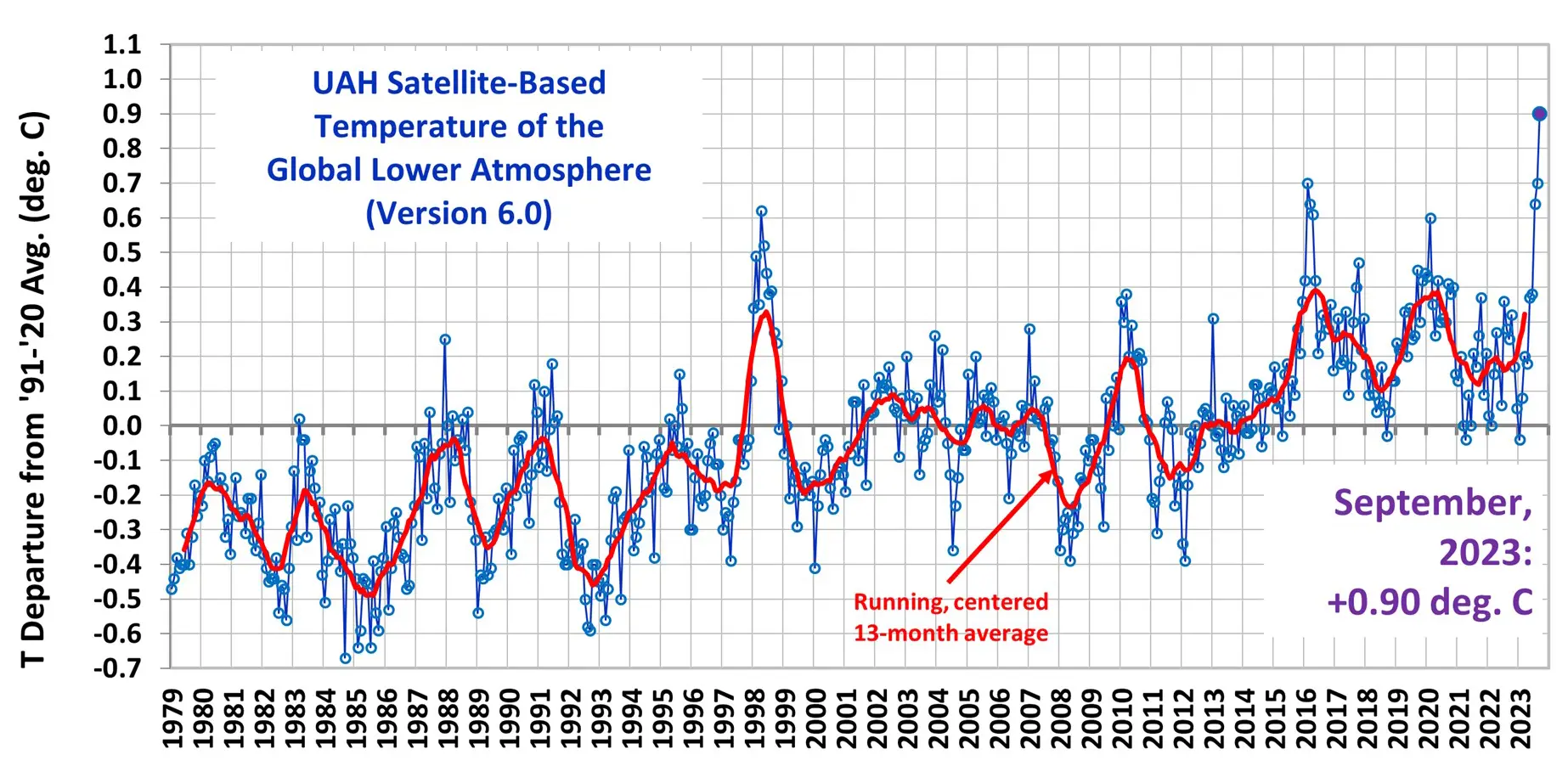
This was totally expected, considering the numerous marine heatwaves and El Nino(warm tropical Pacific). There is always a lag of numerous months for the atmosphere to respond to additional warmth belching out of the oceans.
In addition, we continue to have modest, mostly beneficial greenhouse gas warming superimposed on the atmosphere longer term to the tune of around +0.14 Deg. C every decade. This is +1.4 Deg. C/century.
The vast majority of life on this greening planet is doing BETTER now/current conditions vs 100 years ago. Plants, light years better.
Plants will almost all continue MUCH better thru at least the next 100 years(because of the the role of CO2 in the indisputable law of photosynthesis).
Most life should also benefit but some life(coral reefs) will suffer increasing damage with higher CO2 levels and continued global warming.
UAH Global Temperature Update for September, 2023: +0.90 deg. C
https://wattsupwiththat.com/2023/10/02/uah-global-temperature-update-for-september-2023-0-90-deg-c/
 The linear warming trend since January, 1979 still stands at +0.14 C/decade (+0.12 C/decade over the global-averaged oceans, and +0.19 C/decade over global-averaged land).
The linear warming trend since January, 1979 still stands at +0.14 C/decade (+0.12 C/decade over the global-averaged oceans, and +0.19 C/decade over global-averaged land).
Regional High Temperature Records for September, 2023
From our global gridpoint dataset generated every month, there are 27 regional averages we routinely monitor. So many of these regions saw record high temperature anomaly values (departures from seasonal norms) in September, 2023 that it’s easier to just list all of the regions and show how September ranked out of the 538 month satellite record:
metmike: I underlined and listed in bold letters the regions with new records below:
Globe: #1
Global land: #1
Global ocean: #1
N. Hemisphere: #2
N. Hemisphere land: #1
N. Hemisphere ocean: #4
S. Hemisphere: #1
S. Hemisphere land: #1
S. Hemisphere ocean: #1
Tropics: #6
Tropical land: #2
Tropical ocean: #8
N. Extratropics: #2
N. Extratropical land: #1
N. Extratropical ocean: #4
S. Extratropics: #1
S. Extratropical land: #1
S. Extratropical ocean: #1
Arctic: #11
Arctic land: 7th
Arctic ocean: 65th
Antarctic: 15th
Antarctic land: 26th
Antarctic ocean: 14th
USA48: 144th
USA49: 148th
Australia: 12th
The vast majority of life on this greening planet is doing BETTER now/current conditions vs 100 years ago. Plants, light years better.
A continuation means that plants will almost all continue MUCH better thru at least the next 100 years(because of the the role of CO2 in the indisputable law of photosynthesis).
DeathbyGreening:
https://www.marketforum.com/forum/topic/69258/
https://www.marketforum.com/forum/topic/69258/#69259
Most life should also benefit but some life(coral reefs) will suffer increasing damage with higher CO2 levels and continued global warming.
https://www.marketforum.com/forum/topic/97624/
https://www.marketforum.com/forum/topic/97624/#99102
Re: Thread of the week-7-26-23
By WxFollower - Sept. 19, 2023, 2:04 p.m.
Hey Mike,
Thank you very much!
I’m going to try to post again about how I feel FL Keys coral is in a much worse situation than GBR.
You said, “Will Florida's coral also recover from this years marine heat wave in similar fashion?”
————————
The GBR’s warmest SST month on record was Feb of 2020 (and may still be) with an anomaly of +1.2C. The actual was +29.2C vs normal of +28.0C. Since the warmest normal is Feb, that means Feb of 2020 was also 1.2C warmer than the warmest normal:
http://www.bom.gov.au/environment/doc/2020-GBR-marine-heatwave-factsheet.pdf
According to this, the coral bleaching threshold (BT) is 1.0C above the month with the warmest normal:
https://coralreefwatch.noaa.gov/product/5km/tutorial/crw08a_bleaching_threshold.php
So, the GBR only barely crossed its BT then (by only 0.2C). In contrast check out how much worse it was in July of 2023 for the Keys’ coral:
The warmest normal SST for the Keys coral is August, which is at 29.6C. July ‘23 was near 32.6C, meaning a whopping 3C above the 29.6 Aug normal!
https://www.wfla.com/wp-content/uploads/sites/71/2023/08/keys-sst-change-2.jpg
So in the Keys, the July ‘23 SST exceeded its BT by a whopping 2.0C vs GBR exceeding its BT by only 0.2C in Feb of 2020. This is why I’m saying the Keys coral is in a much worse situation than the GBR ever was. Hopefully it will recover. But do you see why this is much worse?